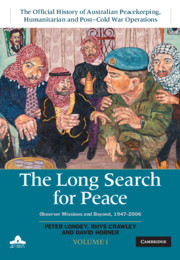Book contents
- The Long Search for Peace
- The Official History of Australian Peacekeeping, Humanitarian and Post–Cold War Operations
- The Long Search for Peace
- Copyright page
- Contents
- Maps
- Preface
- Glossary
- Part 1 Actor and observer
- 1 The origins of peacekeeping
- 2 St George and the maiden
- 3 Inventing peacekeeping
- 4 Failure
- 5 Success
- 6 Observing at a critical moment
- 7 An intractable dispute
- 8 ‘Tough men wanted’
- 9 Australia and the problem of Palestine
- 10 The Six Day War and after
- 11 ‘If you’re not confused, you don’t understand the situation’
- 12 Over jungle and swamp
- 13 A reluctant start
- 14 The first decade
- 15 Australia and the invention of peacekeeping
- Part 2 New ambitions
- Part 3 Carrying on
- Conclusion
- Book part
- Bibliography
- Index
- Plate Section (PDF Only)
15 - Australia and the invention of peacekeeping
from Part 1 - Actor and observer
Published online by Cambridge University Press: 27 September 2019
- The Long Search for Peace
- The Official History of Australian Peacekeeping, Humanitarian and Post–Cold War Operations
- The Long Search for Peace
- Copyright page
- Contents
- Maps
- Preface
- Glossary
- Part 1 Actor and observer
- 1 The origins of peacekeeping
- 2 St George and the maiden
- 3 Inventing peacekeeping
- 4 Failure
- 5 Success
- 6 Observing at a critical moment
- 7 An intractable dispute
- 8 ‘Tough men wanted’
- 9 Australia and the problem of Palestine
- 10 The Six Day War and after
- 11 ‘If you’re not confused, you don’t understand the situation’
- 12 Over jungle and swamp
- 13 A reluctant start
- 14 The first decade
- 15 Australia and the invention of peacekeeping
- Part 2 New ambitions
- Part 3 Carrying on
- Conclusion
- Book part
- Bibliography
- Index
- Plate Section (PDF Only)
Summary
The period of 25 years between the deployment of Australia’s first UN peacekeepers in 1947 and the withdrawal of Australian troops from Vietnam in 1972 marks a distinct phase in Australian peacekeeping, and has been the subject of part 1 of this volume. During that time, with large relatively military commitments in the Korean War, the Malayan Emergency, Confrontation and the Vietnam War, Australia deployed only a handful of military peacekeepers, and the only large group of peacekeepers was the police who went to Cyprus in 1964. The election of the Whitlam Labor government in December 1972 and the end of Australia’s commitment to the Vietnam War, which began to wind down in 1970 and was completed in December 1972, fundamentally changed Australia’s approach to international peacekeeping, and will be discussed in detail in part 2.
- Type
- Chapter
- Information
- The Long Search for PeaceObserver Missions and Beyond, 1947–2006, pp. 378 - 392Publisher: Cambridge University PressPrint publication year: 2019

